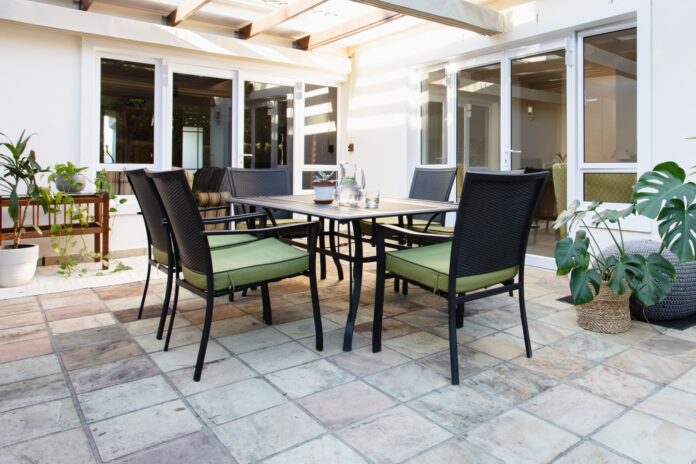It’s great if you have a patio outdoors, where you and your family can relax and enjoy the cool air and open space. If you’re going to be locked down at home, a patio can simply keep you from going nuts from claustrophobia. You do need certain crucial characteristics for your flooring options. Of course, you also have to check your budget, but there are other factors besides the Outdoor Patio Flooring costs.
First off, you’ll need flooring that’s a lot tougher than your regular indoor flooring. That’s because the flooring will need to deal with particular weather and temperature conditions. You’ll also need something really tough if you plan on holding get-togethers on your patio regularly. The flooring has to be able to deal with the traffic, and the potential spills as well.
Then you should also consider the texture of the flooring. Patio floors get wet when it rains, and you don’t want to risk people slipping on the wet floors. With all these factors in mind, here are some flooring options that might work for your outdoor patio:
Table of Contents
Ceramic
Ceramic tiles can work for flooring, but you have to make sure that you get the right type that’s strong enough for the job. To determine this, you have to check the PEI rating from the Porcelain Enamel Institute. You’ll need a class 3 rating (good enough for normal residential foot traffic), though the stronger class 4 is better. Sometimes the ceramic tiles have specific labels, so get the ones specifically marked for outdoor use.
In general, ceramic is not all that strong. That means it’s best for light-use patios, and not for outdoor spaces where you hold parties regularly. This is a good choice for those with a tight budget, as ceramic is usually more affordable than porcelain.
Porcelain
This is a denser and stronger type of ceramic, and it’s a more suitable choice for patios. You just need to make sure that the porcelain tiles you’re getting are marked for patio use.
However, porcelain is generally more expensive than ceramic. It doesn’t help that it’s better if you go with professional installation. Even if you get all the installation knowledge from Home Renovation Guru, the installation is a bit too difficult for those without porcelain installation experience.
You do have a wide range of choices. For patio use, you’re better off with textured matte tiles. The glossy tiles are more dangerous, since they’re slippery when wet.
Travertine
This is a type of natural stone that’s actually a form of limestone. It comes with gorgeous colors and textures, and it’s quite hard as well. All these characteristics help explain why travertine can be quite expensive.
On the other hand, travertine has a somewhat pitted surface where dirt can accumulate. You can minimize this particular problem if you go with a smoothly polished surface, but that will make the flooring more slippery when wet.
There are also differences with travertine depending on where it comes from. Since you want more water-resistant stone, you’ll want travertine from Italy or Turkey, rather than from China or Mexico.
Quarry
Modern quarry tiles don’t come from mines anymore. Instead, they’re made from a particularly dense type of unglazed clay.
Quarry tiles are terrific for outdoor patios. In fact, they were made specifically for patios and courtyards. These tiles are just tough and durable.
In contrast with ceramic and porcelain tiles, quarry tiles offer a rather more limited color range. In most cases, available colors are just gray, brown, and red. But these tiles give off this alluring Mediterranean vibe that really feels classy.
Quarry tiles also offer good water resistance. And even when the tiles get wet, the texture keeps the flooring from turning slippery.
However, quarry files have one notorious drawback: they stain very easily. Also, the quarry tiles aren’t all that good in areas where you have winter seasons with freezing temperatures. But in the right climate, quarry tiles are great.
Soapstone
This is a non-porous type of stone, so you don’t have pits where dirt can accumulate. It’s nicely water-resistant, and even resistant to staining.
Soapstone is quite useful in very warm climates, as the stone is also resistant to heat. But it’s also great with wet, freezing seasons. This is the type of stone you should consider for use around your swimming pool.
Soapstone offers a unique look as well. No two slabs look the same, with colors ranging from gray to green.
Slate
Any list of suitable flooring materials for outdoor patios should include slate. That’s because it’s extremely tough and long-lasting, plus it offers excellent water resistance. You also have plenty of texture options to pick from, and you can go with a non-slippery texture for greater outdoor safety.
Don’t think that all slate tiles come in just black and gray tones. Modern slate options now come in lots more color options. You even have colors like orange, green, and purple!
Once you’ve checked out all these options, you should have a flooring material that’s best for your outdoor patio!





